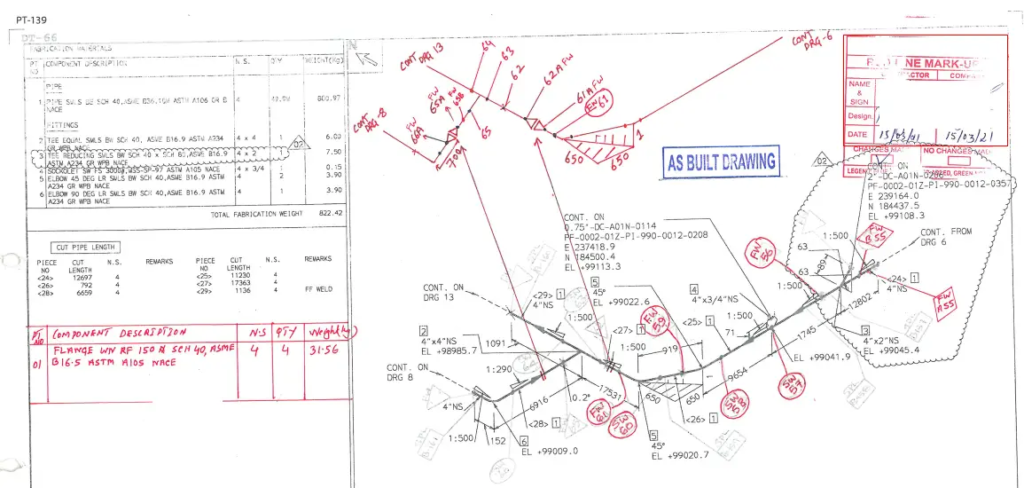As-built drawings are engineering blueprints that portray the real, physical features of a plant, building, or structure after construction has finished. As the construction process unfolds, there might be several deviations from the initial design plans. These alterations and modifications are noted on the original drawings using red markings, creating what is commonly referred to as red-line drawings.
In this article, we’ll delve into the significance of these piping drawings and understand their crucial role in accurately documenting the final state of a project.
As-Built Drawings
In every construction project, the preparation of as-built drawings stands as a crucial process. These engineering documents serve to illustrate all the modifications, field changes, shop drawing updates, pipe routing adjustments, additional work, and more. Simply put, these drawings can be described as an engineering blueprint that records any design change or deviation from the original design document. These drawings are also commonly referred to as record drawings. For reference, you can see a sample of the drawing of a piping isometric in the figure below.

Requirements for As-Built Drawings
As-built drawings offer numerous advantages that play a vital role in the construction industry:
- Accurate Documentation: As-built drawings provide a detailed record of the actual construction, capturing any changes made during various stages. This information is essential for maintenance, repairs, and future renovations, ensuring smooth operations.
- Updating 3D Design Models: The data from as-built drawings is used to update 3D design models to match the real site configuration. This enables easier tracking for future projects and facilitates seamless expansions or remodeling.
- Effective Asset Management: With comprehensive records of the physical characteristics of plants, buildings, or structures, as-built drawings contribute to efficient asset management.
- Cost and Time Savings: By identifying potential issues early on, as-built drawings help prevent major problems, leading to cost and time savings in the long term.
- Informed Purchasing Decisions: As-built drawings become crucial documents for potential buyers, offering a clear understanding of what they are getting for their investment. They also serve as a solid foundation for any future modifications or improvements.
In summary, as-built drawings serve as invaluable resources that enhance project accuracy, streamline future endeavors, and optimize overall construction efficiency.
Accountability for As-Built Drawings
The task of preparing red-line or as-built drawings is typically assigned to the architect, engineer, or contractor responsible for overseeing the construction of the plant or building. In the context of an oil and gas project, site engineers are usually the ones in charge of creating the as-built drawings. These drawings encompass any design changes made during construction due to unforeseen circumstances, carefully marked to reflect the actual changes made.
In some instances, a specialized team or individual might be brought in specifically to handle the creation of as-built drawings. However, the person entrusted with this responsibility must possess a thorough understanding of the plant, structure, or building to ensure the accurate documentation of its true physical characteristics.
As time progresses, maintenance engineers may also play a role in updating the as-built drawings if any changes occur during maintenance work. These changes, arising from various reasons and deviations from the original design, must be diligently recorded and stored for future reference.
It is important to note that, in certain cases, plant owners may consider the completion of as-built drawings as a crucial criterion for successful project handover and commissioning. Additionally, local regulations may demand final as-built drawings for certifications, permits, inspections, and legal purposes.

In summary, the responsibility of creating as-built drawings rests upon qualified professionals who are intimately familiar with the construction project, ensuring the accuracy and completeness of these vital engineering documents.
Contents of an As-built Drawing
The task of preparing red-line or as-built drawings is typically assigned to the architect, engineer, or contractor responsible for overseeing the construction of the plant or building. In the context of an oil and gas project, site engineers are usually the ones in charge of creating the as-built drawings. These drawings encompass any design changes made during construction due to unforeseen circumstances, carefully marked to reflect the actual changes made.
In some instances, a specialized team or individual might be brought in specifically to handle the creation of as-built drawings. However, the person entrusted with this responsibility must possess a thorough understanding of the plant, structure, or building to ensure the accurate documentation of its true physical characteristics.
As time progresses, maintenance engineers may also play a role in updating the as-built drawings if any changes occur during maintenance work. These changes, arising from various reasons and deviations from the original design, must be diligently recorded and stored for future reference.
It is important to note that, in certain cases, plant owners may consider the completion of as-built drawings as a crucial criterion for successful project handover and commissioning. Additionally, local regulations may demand final as-built drawings for certifications, permits, inspections, and legal purposes.
In summary, the responsibility of creating as-built drawings rests upon qualified professionals who are intimately familiar with the construction project, ensuring the accuracy and completeness of these vital engineering documents.
Characteristic Features of As-Built Drawings
The process of creating as-built drawings can vary slightly between different organizations, but they typically share the following key features:
- Timing of Preparation: As-built drawings are typically prepared during or immediately after the construction of the facility. This ensures that any changes made during the construction process are accurately recorded.
- Marking Changes: Modifications are clearly indicated on the original drawings using red ink. While smaller projects may rely on hand-marking with pens, larger endeavors often employ software or typed documents for this purpose.
- Stamped as “As-Built”: All as-built drawings are prominently stamped or labeled as “As-built.” This designation helps distinguish them from the original design drawings.
- Clarity of Changes: The changes made to the original design must be clearly depicted and described in the as-built drawings. This ensures that anyone referring to these documents can easily understand the alterations.
- Avoiding Abbreviations: As-built drawings typically avoid the use of abbreviations. This practice helps prevent confusion and ensures that the information is conveyed accurately and unambiguously.
In summary, regardless of the organization’s specific practices, as-built drawings share these essential characteristics, serving as vital records of any modifications made during the construction process.
Construction Drawings vs. As-Built Drawings: Understanding the Key Differences
In the world of architecture and engineering, construction drawings and as-built drawings serve different purposes throughout the construction process. Here are the key distinctions between the two:
- Purpose: Construction drawings act as guides for the construction phase, providing detailed plans, elevations, sections, specifications, and material lists. On the other hand, as-built drawings are created after construction completion, serving to document the actual physical characteristics of the building or structure.
- Content: Construction drawings focus on critical construction information required to bring the project to life. In contrast, as-built drawings encompass detailed specifics about the building, including the precise locations of walls, doors, windows, and essential systems like electrical, plumbing, and mechanical setups.
- Timing: Construction drawings are prepared before construction work begins, providing essential instructions for builders and contractors. Conversely, as-built drawings are produced after the construction phase concludes, capturing the final state of the structure.
- Audience: Construction drawings are primarily intended for use by contractors, builders, and construction workers, guiding them in implementing the design. On the other hand, as-built drawings cater to the building owner, maintenance staff, and relevant authorities, serving as a reference for compliance and future maintenance.
- Accuracy: Construction drawings are based on design plans and may involve some assumptions or estimated data. As-built drawings, in contrast, must be highly accurate, reflecting the precise physical attributes of the completed building or structure.
- Updating: Construction drawings are generally used only during the construction process and are not regularly updated. In contrast, as-built drawings are periodically updated to reflect any changes or modifications made to the building over time.
By recognizing these fundamental differences between construction drawings and as-built drawings, professionals in the field can effectively utilize both to ensure successful construction projects with accurate documentation.
Conclusion
In conclusion, while the significance of as-built drawings cannot be understated, their creation sometimes faces challenges due to a lack of motivation and commitment, resulting in inadequate record-keeping. To enhance the process and ensure more accurate documentation, implementing the following strategies can be beneficial:
- Early Initiation: Begin preparing as-built drawings right from the start of the construction phase. By doing so, potential changes and modifications can be recorded promptly, ensuring a comprehensive and up-to-date documentation process.
- Cultivate As-Built Culture: Make creating as-built drawings a fundamental aspect of every construction project. Cultivating a culture that prioritizes accurate and timely documentation will contribute to the overall success of the project and its future maintenance.
- Utilize Advanced Tools: Leveraging various technologies like Laser scanning, Building Information Modeling (BIM) data, and actual site photos can significantly enhance the quality of as-built information. These tools provide more precise and detailed data, resulting in more accurate representations of the completed structure.
By adopting these strategies, construction professionals can overcome the challenges and improve the creation of as-built drawings, leading to better project management, streamlined maintenance, and compliance with regulatory requirements. Ultimately, a stronger commitment to creating thorough and reliable as-built drawings benefits all stakeholders involved in the construction and life cycle of the building or structure.
Online Video Course on Piping Isometrics
If you wish to explore more about piping isometrics, you can opt for the following online video course











